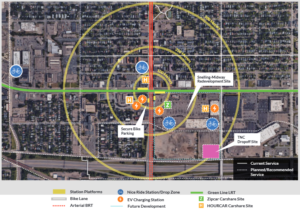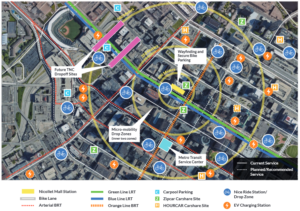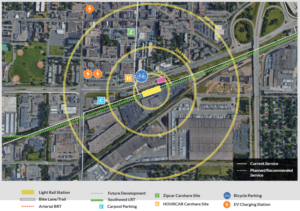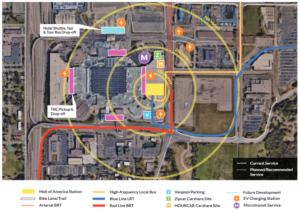Mobility Hubs: Where People Go to Move, Shared-Use Mobility Center, 2019
10 minutes Date Launched/Enacted: Feb 27, 2019 Date Published: June 14, 2022
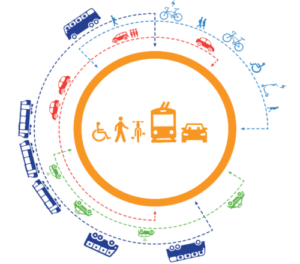
Introduction
Today we have more ways to get around our cities than ever before—from bikesharing to scooters, carshare to ridehailing. But the many benefits of this expanding menu of options can only be realized if they are integrated into a coherent network of efficient transportation options that lets people get where they need to go using whatever mode makes the most sense for them on a particular trip. Enter the mobility hub—a place where people can seamlessly connect with multiple modes of transportation in a safe, comfortable, and accessible environment.
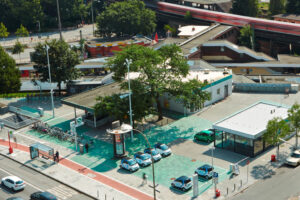
In Europe, hubs like this one in Hamburg have connected people and transportation for over a decade.
The Shared-Use Mobility Center studied some of the most innovative examples for the 2018 FHWA report Shared Use Mobility: European Experience and Lessons Learned. View it at: https://international.fhwa.dot.gov/sum/fhwapl18026.pdf
Pioneered in Germany and found today throughout Europe, mobility hubs provide physical integration among modes by co-locating carsharing, bikesharing, and other shared-mobility services close to public transit stops and large residential developments. With their physical presence and clear, prominent branding, these spaces offer visibility to and connection between public transit and shared mobility services that in turn support multimodal living and reduced dependence on personal cars and solo driving.
10 Strategies for Making Successful Mobility Hubs
- Build around strong transit stops: Transit, the original shared mobility service, is the core on which a diverse array of options depends. When locating a mobility hub, the first thing to look for is a site with high-frequency transit service. This service forms a strong backbone of activity to enable and support other modes.
- Incorporate electrification: When siting a mobility hub, ensure that there is sufficient electrical power available to support the electrification of a variety of modes, even if they are planned for a later date.
- Leverage momentum in transit-oriented development: The most used hubs will be where people already live and work. Mobility hubs are a natural complement to transit oriented development initiatives.
- Ensure users’ safety: Mobility hubs should feel safe, with good lighting both within and on pedestrian approaches, a location in well trafficked areas with good visibility to ensure that users feel comfortable both in their access to and presence in a hub.
- Emphasize comfort and a seamless pedestrian experience: Mobility hubs should be walkable and accessible for all ages and abilities. All hubs should provide basic comfort features including seating and protection from the elements, established traffic-calming elements, and an enhanced pedestrian realm in the surrounding area.
- Offer a sense of place: As a public space, a mobility hub should be designed for the people using it, and provide a welcoming and useful experience to the surrounding community. Placemaking elements can vary based on the type of mobility hub, but should reflect the surroundings and maintain the core function of facilitating accessible and reliable travel using multiple modes. Hub locations can be used for cultural events like festivals or farmers markets, or co-located with facilities where people convene. This can be anything from a pleasant garden space, art installations, cafés, community centers, or other gathering spots.
- Provide plenty of options: Mobility hubs need multiple forms of transportation—three at a minimum. With the hassle of car parking acting as a behavioral “stick,” the convenience of a “one-stop-shop” where riders can walk up and select the mobility option that best meets their needs can act as the “carrot.”
- Support seamless transfers and integration into the surrounding neighborhood through well designed wayfinding: To support use of these transportation options, hubs should offer wayfinding resources (both for the transit system and destinations within the hub’s immediate environs) via tablets, interactive kiosks or physical maps. When feasible, provide staffed hubs with assistance available to explain how to use the various modes and services.
- Make mobility hubs visible: Consistent branding and design across hub locations is important in establishing a sense of a system and an expectation of the features at any given location. This consistency also helps inform travelers that each mobility hub is part of a larger network that can be used to connect people to their destinations, and establish a sense of reliability and routine in encountering and using them.
- Market and educate the public: People should know that mobility hubs are available, that they provide choices, and that they are safe and easy to use.
Mobility Hub Features
Essential design features:
- Sheltered waiting areas with seating (and heating or cooling, as appropriate) to provide comfort for wait times
- Lighting for functional, safety and decorative purposes
- Signage with real-time arrival/departure schedules for all available modes of transit
- Fare payment stations or complimentary wi-fi to facilitate purchase of tickets or sign-ups for transportation services
- Visual wayfinding that clearly direct users to the different transportation options, nearby businesses and landmarks, hub amenities, and information on how to sign up for and use all the modes
Additional features to expand use include:
- Placemaking and community building to ensure a welcoming and useful experience through public art, landscaping, retail outlets, parklets, interactive design, and connections to the neighborhood.
- Drinking fountains and/or bathrooms to enhance comfort and desirability of space
- Storage and/or urban freight facilities such as package lockers to relieve pain points of traveling with or sending/receiving medium- or larger-sized goods
Essential transportation amenities:
- High-frequency transit is the backbone of a mobility hub, supporting the other modes and bringing
people to and from locations - Pedestrian walkways to prioritize walking and allow for safe and clear access to transit boarding zones
- Bike access and parking to accommodate connections by people using personal bicycles
Additional features to expand multimodal options include:
- Pickup and drop-off zones for ridesharing services, shuttles, and TNCs and taxis
- Support for microtransit services that can facilitate connections in situations and environments that public transit can’t efficiently serve
- Micromobility (bike and scooter) services using physical docks or geo-fenced “corrals”
- Carshare parking for round-trip and one-way services, depending on local availability
- Electric vehicle charging for use by shared or privately owned electric vehicles. Ideally these should be DC fast charging (Level 3) for faster turnover but can also be Level 2.
- Secure bike parking for storage longer than a few hours
- Car parking, with priority for car- or vanpools
Mobility Hubs in Context
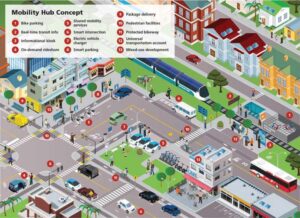
Early concept of mobility hubs developed by the San Diego Association of Governments (SANDAG). Modes and terminology continues to evolve. SANDAG is now developing a plan to build out a network of mobility hubs.
While there’s no universal definition or description of where a Mobility Hub should be located or what it should entail, there are common themes. Several communities have put their own spin on the description, important features, and siting principles of mobility hubs, including Metrolinx in Toronto; LA Metro; and the San Diego Association of Governments. Leaders in Denver, the Twin Cities, Seattle, and other cities are following suit. Few North American regions have progressed significantly on these plans.
In addition to a transit station or bus stop, planning for mobility hubs should consider the immediate walkable area (within about one quarter mile) so that multiple modes can be co-located and it can be comfortably accessed on foot, bike, or other non-auto transportation. The location of a viable mobility hub can vary according to its underlying goals—as well as space and density considerations. For instance, it can be a priority to locate a hub at a transit-oriented development served by at least one high-frequency transit line.
Design elements of a mobility hub will differ according to nearby land use, available space, and the role a station plays within a broader transit network.
Mobility hubs can be classified into four groups, based on the type of transit service available at that location and how the space fits into the context of the surrounding community:
Type of transit service
A branch hub is a point of entry into a high-frequency transit network, typically outside of a region’s core. These locations are often, but not exclusively, found in lower density and less walkable communities and are served by a limited number of connecting routes. Branch hubs can support services that help people cover the first or last mile of their trip. Their surrounding area may require traffic calming to support non-motorized transportation.
A trunk hub is situated closer to the core of the high-frequency transit network, as opposed to on the periphery. These locations are served by multiple connecting routes and are routinely part of more developed and walkable communities that are likely to have a higher density than those on the region’s outer edge. Areas with purely urban land use host trunk hubs, as do many with a mix of urban and suburban features, and some dense suburbs. As a function of this density, trunk hubs are suited to host micromobility services such as bikeshare and scooters.
Functional context
Destination hubs can be either branch or trunk varieties. The designation is influenced by whether or not its location stands on its own as one that people travel to and gather at for non-transportation related reasons year round. A destination hub is proximate to several attractions, such as retail, educational institutions, hospitals, or cultural attractions. Trunk hubs are more likely to serve a destination function, but branch hubs can as well, such as airports, stadiums, or shopping malls.
Hubs without a clear destination function, especially those that largely serve areas without regional significance, are designated as local hubs. Again, while these are more likely to be of the branch type, a trunk hub can also serve largely local functions, such as a neighborhood commercial area at the intersection of several high-frequency bus lines. A local hub should have a longer list of design treatments to call attention to and support its status as a place.
Examples from the Twin Cities
The Twin Cities Shared Mobility Action Plan, produced by SUMC in 2017, recommended that local leaders plan for and build integrated mobility hubs, focusing on implementation of the hubs alongside transit capital and service improvement projects. The following examples are from locations with high projected population or job growth and high potential to support shared mobility. The examples approximate current and near-future infrastructure improvements and are illustrative, not absolute. Community engagement is crucial throughout the process of creating mobility hubs.
Trunk Local: Snelling and University Avenue, Saint Paul, MN
At the intersection of the light rail line between downtown Minneapolis and downtown Saint Paul and a high frequency BRT line, Snelling and University currently hosts local commercial activity. The area includes a bikeshare station, two sites for EV charging,
and a carshare parking spot that will be developed into EV carshare. The light rail station is partially covered, with heat lamps and seating. While this site features a light rail stop and BRT line, similar infrastructure could support many sites with two or more high frequency bus stops. The area will soon expand as a destination as a 34.5 acre redevelopment project is underway that will include a major league soccer stadium. It would benefit from enhanced amenities such as secure bike parking and dedicated micromobility parking, a drop off/pickup zone, drinking fountains, and restrooms.
Trunk Destination: Nicollet Mall and Fifth Street, Minneapolis, MN
Located in the heart of downtown Minneapolis on a heavily trafficked pedestrian mall, this area is served by two light rail lines, multiple high frequency bus routes, with four BRT lines planned for the near future. There are many nearby destinations, including office buildings and shopping. Bikeshare and scooters are amply available. A gift shop adjacent to the transit stop allows visitors to purchase transit passes and obtain local information. While the area could host EV fast charging and expand the hours at which staffed customer service is available, in most regards this is a “naturally occurring” fully functional mobility hub.
Branch Local: Downtown Hopkins Station, Hopkins, MN
A two block walk from downtown Hopkins, MN, this site will host a stop for the planned Southwest LRT line, a south and westward extension of the Green Line from Saint Paul to Minneapolis. Located adjacent to the Minnesota River Bluffs regional trail, the station’s
park & ride lot will be converted into a public plaza, and it will feature a nearby ‘kiss & ride’ for dropoffs. The station will host informational kiosks and bike racks and include a sheltered passenger waiting area. Plans call for mixed-use development a block away from the site. The site would benefit from long-term bike parking, offsite carshare and EV charging, carpool priority parking, wayfinding to attractions in downtown Hopkins, and activities in the plaza.
Branch Destination: Mall of America, Bloomington, MN
The Mall of America is among the busiest transit hubs in the state of Minnesota. It hosts a light rail terminus, a high-frequency bus to downtown Saint Paul and eight additional local bus service routes and EV charging. In 2019, leaders broke ground on a $25M renovation to the transit center that will include improved lighting, a family restroom,
emergency telephones, real-time departure signs, and important pedestrian safety improvements. The hub could further be improved with traffic calming for bicycle and pedestrian connections, bicycle amenities, added carshare service and parking, DC fast charging, TNC/taxi pickup and dropoff zones, and added shuttle service to nearby employers.

